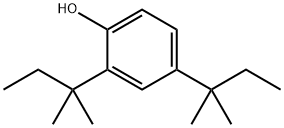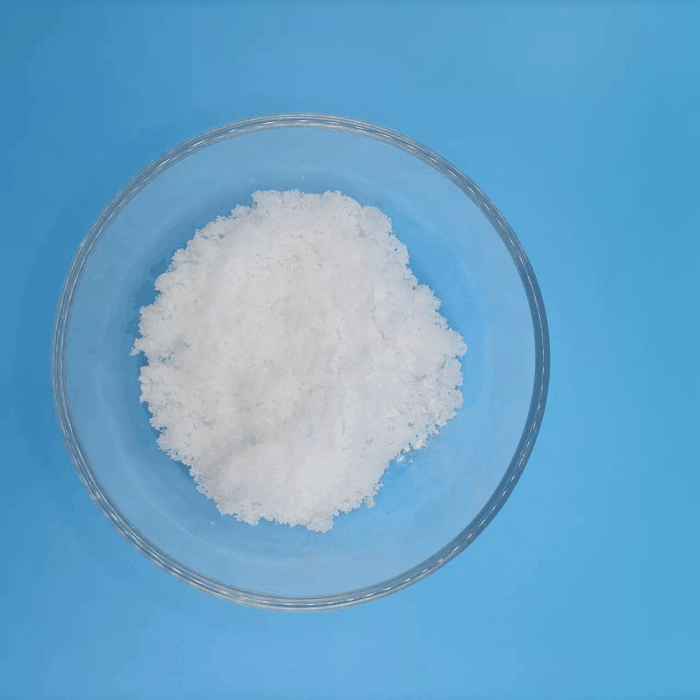2,4-Di-tert-pentylphenol
- CAS NO.:120-95-6
- Empirical Formula: C16H26O
- Molecular Weight: 234.38
- MDL number: MFCD00041929
- EINECS: 204-439-0
- SAFETY DATA SHEET (SDS)
- Update Date: 2024-12-18 14:15:30

What is 2,4-Di-tert-pentylphenol?
Chemical properties
clear yellow liquid after melting
The Uses of 2,4-Di-tert-pentylphenol
UV Stabilizer Intermediate, Photographic Developers, Specialty Surfactants, Fuel Additive Intermediate
The Uses of 2,4-Di-tert-pentylphenol
2,4-Di-tert-amylphenol is a phenolic compound, used for the laccase induced coupling reactions. It may be used in the synthesis of Cu-phthalocyanine-C60.
General Description
The standard molar enthalpies of sublimation (or vaporization) of 2,4-di-tert-amylphenol have been evaluated. Preparation of 2,4-di-tert-amylphenol, via catalytic alkylation of phenol with trimethylethylene, is reported.
Safety Profile
Poison by ingestion. An eye irritant. When heated to decomposition it emits acrid smoke and irritating fumes. See also PHENOL.
Properties of 2,4-Di-tert-pentylphenol
| Melting point: | 25 °C (lit.) |
| Boiling point: | 169-170 °C/22 mmHg (lit.) |
| Density | 0.930 g/mL at 25 °C (lit.) |
| refractive index | 1.506-1.508 |
| Flash point: | >230 °F |
| storage temp. | 2-8°C |
| form | powder to lump to clear liquid |
| pka | 11.00±0.31(Predicted) |
| color | White or Colorless to Almost white or Almost colorless |
| Water Solubility | 3mg/L at 21℃ |
| CAS DataBase Reference | 120-95-6(CAS DataBase Reference) |
| NIST Chemistry Reference | 2,4-Di-tert-amyl phenol(120-95-6) |
| EPA Substance Registry System | 2,4-Di-tert-amylphenol (120-95-6) |
Safety information for 2,4-Di-tert-pentylphenol
| Signal word | Warning |
| Pictogram(s) |
 Exclamation Mark Irritant GHS07  Health Hazard GHS08  Environment GHS09 |
| GHS Hazard Statements |
H302:Acute toxicity,oral H319:Serious eye damage/eye irritation H371:Specific target organ toxicity, single exposure H410:Hazardous to the aquatic environment, long-term hazard |
| Precautionary Statement Codes |
P260:Do not breathe dust/fume/gas/mist/vapours/spray. P264:Wash hands thoroughly after handling. P264:Wash skin thouroughly after handling. P270:Do not eat, drink or smoke when using this product. P273:Avoid release to the environment. P280:Wear protective gloves/protective clothing/eye protection/face protection. P391:Collect spillage. Hazardous to the aquatic environment P305+P351+P338:IF IN EYES: Rinse cautiously with water for several minutes. Remove contact lenses, if present and easy to do. Continuerinsing. P405:Store locked up. P501:Dispose of contents/container to..… |
Computed Descriptors for 2,4-Di-tert-pentylphenol
2,4-Di-tert-pentylphenol manufacturer
SI Group India Limited
1Y
Phone:+91-2356660401
Whatsapp: 91-23-56660401
product: 120-95-6 2,4-Bis(1,1-dimethylpropyl)phenol 99%
New Products
Tert-butyl bis(2-chloroethyl)carbamate (S)-3-Aminobutanenitrile hydrochloride N-Boc-D-alaninol N-BOC-D/L-ALANINOL 3-(2,4-Dimethoxybenzyl)dihydropyrimidine-2,4(1H,3H)-dione 7-Bromo-1H-indazole N-octanoyl benzotriazole 3,4-Dibenzyloxybenzaldehyde 4-Hydrazinobenzoic acid Electrolytic Iron Powder Fmoc-Val-Cit-PAB 1,1’-CARBONYLDIIMIDAZOLE R-2-BENZYLOXY PROPIONIC ACID 4-HYDROXY BENZYL ALCOHOL 1,1’-CARBONYLDI (1,2-4 TRIAZOLE) S-2-CHLORO PROPIONIC ACID (2-Hydroxyphenyl)acetonitrile 4-Bromopyrazole 5-BROMO-2CYANO PYRIDINE 5,6-Dimethoxyindanone 5-broMo-2-chloro-N-cyclopentylpyriMidin-4-aMine 1-(4-Methylphenylsulfonyl)-1H-1,2,3-benzotriazole 1-(2-Chlorobenzyl)-4-nitro-1H-pyrazole 1-(2-Nitrophenyl)-4-phenylpiperazineRelated products of tetrahydrofuran






![4-[2,4-Bis(1,1-dimethylpropyl)phenoxy]-1-butanamine](https://img.chemicalbook.in/CAS/GIF/51959-14-9.gif)

You may like
-
 120-95-6 2,4-Bis(1,1-dimethylpropyl)phenol 99%View Details
120-95-6 2,4-Bis(1,1-dimethylpropyl)phenol 99%View Details
120-95-6 -
 2,4-Di-tert-amylphenol CAS 120-95-6View Details
2,4-Di-tert-amylphenol CAS 120-95-6View Details
120-95-6 -
 Ste-Glu-AEEA-AEEA-OSUView Details
Ste-Glu-AEEA-AEEA-OSUView Details
1169630-40-3 -
 1446013-08-6 Fmoc-His-Aib-OH TFA 98%View Details
1446013-08-6 Fmoc-His-Aib-OH TFA 98%View Details
1446013-08-6 -
 127464-43-1 99%View Details
127464-43-1 99%View Details
127464-43-1 -
 Chloro Uracil 99%View Details
Chloro Uracil 99%View Details
1820-81-1 -
 2-ETHYLPYRIDINE 100-71-0 99%View Details
2-ETHYLPYRIDINE 100-71-0 99%View Details
100-71-0 -
 13162-05-5 99%View Details
13162-05-5 99%View Details
13162-05-5
Statement: All products displayed on this website are only used for non medical purposes such as industrial applications or scientific research, and cannot be used for clinical diagnosis or treatment of humans or animals. They are not medicinal or edible.